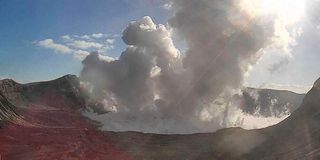Climate fact check: Human activities emit more CO2 than volcanic eruptions

This handout photo taken and received on March 26, 2022 from the Philippine Volcanology and Seismology shows the Taal volcano, which sits in a picturesque lake in Batangas province, after an eruption sent ash and steam hundreds of metres into the sky.
About 10 years ago, the European Geosciences Union wrote that some Kenyan volcanoes have become active, with Mt Longonot posing the largest risk.
And while volcanic eruptions may burn everything to ash, there is also the concern of carbon dioxide released into the atmosphere.
When a volcano in Greece erupted, misinformation arose, with some users claiming that it put more carbon dioxide in the atmosphere in 24 hours than humans have in our entire existence.
The claim read: “Just a reminder that a volcano in Greece has put more CO2 in the atmosphere in 24 hours than humans have in our entire existence.”
However, this is untrue.
The US Geological Survey states that volcano emissions comprise just less than one percent of carbon dioxide emitted by human activity.
It details that volcanoes on land and under the sea produce about 200 million tons of carbon dioxide in a year, as compared to 24 billion tons produced yearly from automotive and industrial activities globally.
It also notes that carbon dioxide from volcanic eruptions has yet to cause any detectable global warming of atmosphere. This is in comparison to sulfur dioxide, also released in eruptions, which has “occasionally caused detectable global warming.”
“In 2010, human activities were responsible for a projected 35 billion metric tons of CO2 emissions. All studies to date of global volcanic carbon dioxide emissions indicate that present-day subaerial and submarine volcanoes release less than a percent of the carbon dioxide released currently by human activities. While it has been proposed that intense volcanic release of carbon dioxide in the deep geologic past did cause global warming, and possibly some mass extinctions, this is a topic of scientific debate at present,” says the US Geological Survey
“There is no question that very large volcanic eruptions can inject significant amounts of carbon dioxide into the atmosphere. The 1980 eruption of Mount St. Helens vented approximately 10 million tons of CO2 into the atmosphere in only 9 hours. However, it currently takes humanity only 2.5 hours to put out the same amount. While large explosive eruptions like this are rare and only occur globally every 10 years or so, humanity's emissions are ceaseless and increasing every year,” it adds.
According to Climate.gov, human activities, involving burning of fossil fuels, deforestation and production of cement contributed about 40 billion metric tons of carbon dioxide in 2015.
“Volcanoes emit carbon dioxide in two ways: during eruptions and through underground magma. Carbon dioxide from underground magma is released through vents, porous rocks and soils, and water that feeds volcanic lakes and hot springs. Estimates of global carbon dioxide emissions from volcanoes have to take both erupted and non-erupted sources into account.”
The claim is therefore false.
This fact check was produced by Nation with support from Code for Africa’s Pesa Check, International Fact Checking Network, and African Fact Checking Alliance Network





